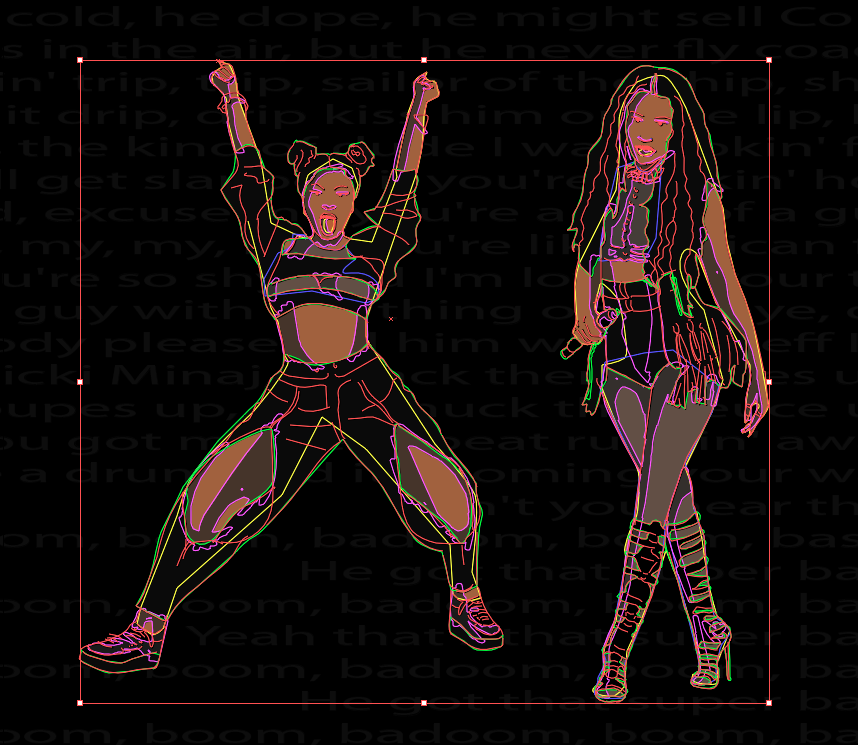[Written by Daniel Castro (he/him)]
[Art by Ella Edwards (she/her)]
‘Let’s be real, all you bitches wanna look like me, wanna be in demand, get booked like me’ – Onika Tanya Maraj-Petty, 2018, ‘Barbie Tingz’.
Indeed she was right, in many ways Nicki Minaj set the standard for female rap for a whole decade after making her main stage debut in 2009. For a long time (and even still), the female rap landscape mimicked the rap persona that Minaj created for herself in the early 2010’s. Her colourful wigs, camp fashions and animated flows, allowed her to cement herself not only as a chart-topping rapper but also as one of mainstream pop music’s major players. The trend of blending hip-hop with pop hooks to captivate a wider audience, became the industry standard for not only upcoming female rappers but also established pop singers. Nicki Minaj oscillated between releasing explosive electropop tracks like ‘Starships’, to outshining rap titans Jay-Z and Kanye West on ‘Monster’. As Jay and Kanye learnt the hard way, asking Nicki to feature on a song is a double-edged sword; you run the risk of relinquishing the whole track to her.
But Nicki Minaj isn’t the only woman who managed to make a name for herself in the locker-room that is the rap game, in fact, she wasn’t even the first to pose in a pink wig. Until recently, there has only been one dominant female rapper at a time, and before Nicki there was Lil’ Kim. When she first came out on the scene in 1995, Lil’ Kim was the only female member of the American hip-hop collective ‘Junior M.A.F.I.A’, but nowadays her legacy is underappreciated. Over two decades ago, draped in fur coats and designer clothes, Lil’ Kim was rapping about sex, money and more, when female sexuality and ambition were more socially shunned than they are today. Embracing her sex-appeal, Lil’ Kim managed to have an impact on fashion spheres, exploring uncharted territory with her style. In a famous promotional image for her 1996 LP ‘Hard Core’, she poses in a leopard print two-piece swimsuit and a mink coat, asserting her sexual confidence in a spread-eagled squat which many female rappers would go on to pay homage to. Suffice to say, Nicki Minaj and Lil’ Kim are two of the most influential women in the genre.
Nonetheless, you’d have to be living under a rock to think that these two have been the only influential women in rap. Artists like Missy Elliot, Foxy Brown, MC Lyte and Queen Latifah are often glossed over when speaking about the realm of female hip-hop. With the current deluge of female rappers on the come up there’s more to talk about than ever before, but one constant that has permeated our culture since the dawn of female rap, is the societal backlash. Most recently in the never-ending string of cases where women have been lambasted for their sexual image, Cardi B and Megan The Stallion’s ‘WAP’ has drawn controversy and criticism. Many lashed out at the performers for being too vulgar, and others accused them of being shallow for discussing sex in their music, but it’s a double-standard. Men in the same positions simply don’t draw the same criticisms, when in fact female sexuality is exploited by men in the music industry at large. Men and women aren’t held to the same standards, and it’s clear to see that expressions of female sexuality are only deemed socially acceptable when the narratives are owned by men. Frankly, Cardi and Megan aren’t responsible for what young children view on the internet, and women shouldn’t be asked to repress themselves to protect outdated ideas of ‘acceptable’ sex in relation to morality.
So let’s be real, why wouldn’t female rappers discuss sex? Male hip-hop heads often criticise women for ‘only ever rapping about the same thing’, but it doesn’t take a detective’s hat and a magnifying glass to see that it’s just not true. It’s only natural that songs about sex would be amongst the most visible in the genre. It can be empowering for women to talk about the very things that they’ve been told to repress, just to prolong the existence of patriarchal ideals. And if listening to it isn’t your cup of tea, that’s fine! The freedom to discuss sex in art should lie with the artist, and not with the likes of non-black misogynists who refuse to accept the value of rap music in the first place.
I suppose it’s to be expected that female rap is threatening to some. Recurring motifs like ‘spending his money instead of mine’ are subversive in their exploitation of entrenched patriarchal structures. These kinds of confident and assertive boasts are sure to make some men very uncomfortable, as their social dominance is being undermined. Female rap is a direct threat to established perceptions of ‘acceptable’ female behaviour, and it’s not a surprise that some people want to preserve a culture that works so well in their favour. I for one, love to see progress being made, with more and more black women creating space for themselves in the public eye. I don’t know about you, but I will be buying a one-way ticket to the WAP house the second it opens its door to visitors.

